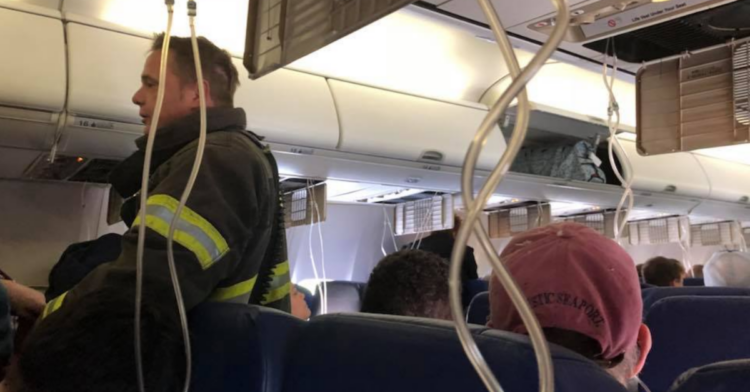If you’ve ever flown, you’ve seen a flight attendant give a safety demonstration before takeoff showing how to deal with various emergencies that may arise during flight.
And how closely you pay attention to that presentation depends a lot on how much you’ve flown before. If it’s your first time, you’ll probably study it like you’re going to be tested on that information later. But if you’re a frequent flyer, you’re more likely to just feel annoyed that somebody interrupted you while you were trying to decide which movies to watch.
But despite the fact that this warning has more or less the same information in it every time, that apparently didn’t stop the passengers of one difficult flight from forgetting a very important piece of it.
On April 18, 2018, Southwest Airlines Flight 1380 from New York City to Dallas had to make an emergency landing in Philadelphia after one of the engines exploded.

According to the BBC , an investigation of the aircraft after the fact determined that one of the engine’s fan blades broke off after experiencing metal fatigue.
Prior to the landing, pilot Tammie Jo Shults told air traffic controllers, “We have a part of the aircraft missing, so we’re going to need to slow down a bit.”
The former Navy pilot — pictured in the foreground in this Twitter user’s photo — was at the controls at the time of the landing and is credited alongside her flight crew for keeping 149 passengers afe.
In addition to making the plane harder to land, this explosion shattered one of the plane’s windows.

As the BBC reported , this new hole in the plane almost created enough force to suck one passenger out of the plane entirely, but she was pulled back in by others.
Sadly, the passenger identified as Jennifer Riordan would later pass away after being rushed to a hospital in critical condition.
Seven others would be treated for minor injuries after the landing, but they were lucky to have made it to the ground alive.

That’s because the same cabin depressurization that almost pulled Riordan out of the aircraft also necessitated the deployment of the oxygen masks that you see in one passenger’s photo.
And unfortunately, another photo from that flight shows that many of those aboard weren’t wearing those masks properly.

In this photo, for example, we can confirm that the passenger in the background to the left of the Bass Pro Shop hat was wearing the mask over his mouth and nose.
However, we can see at least four people in this shot who only covered their mouths with it. And that can make a world of difference when you’ve lost cabin pressure.
That’s because air pressure plays a more important role in our ability to breathe than many of us realize.

According to the Federal Aviation Administration , the actual percentage of oxygen in the air doesn’t change as you reach high altitudes.
The problem is that the higher you go, the more spread apart those oxygen molecules become, which means they exert less pressure per square inch. Without sufficient pressure, the lungs cannot concert enough oxygen from ambient air to oxygenate the blood, which causes a potentially life-threatening condition called hypoxia.
To put it another way, when somebody drowns, they’re experiencing hypoxia.
So while an airplane’s oxygen masks are designed to protect passengers from hypoxia with a sufficiently pressurized oxygen supply, they can only do so much if they aren’t worn properly.

If the aircraft’s cabin pressure situation had been more dire, there’s a good chance that this firefighter would have had far more than one patient in critical condition to deal with when he climbed aboard.
Hopefully, this story will remind us to be a little more alert the next time a flight attendant gives us a safety demonstration.
h/t: BBC

















































